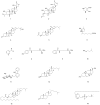The Significant Therapeutic Effects of Chinese Scorpion: Modern Scientific Exploration of Ion Channels
- PMID: 39770577
- PMCID: PMC11678150
- DOI: 10.3390/ph17121735
The Significant Therapeutic Effects of Chinese Scorpion: Modern Scientific Exploration of Ion Channels
Abstract
Chinese scorpion (CS), a traditional animal-based medicine used for over a millennium, has been documented since AD 935-960. It is derived from the scorpion Buthus martensii Karsch and is used to treat various ailments such as stroke, epilepsy, rheumatism, and more. Modern research has identified the pharmacological mechanisms behind its traditional uses, with active components like venom and proteins showing analgesic, antitumor, antiepileptic, and antithrombotic effects. Studies reveal that CS affects ion channels, crucial for cellular functions, through interactions with sodium, potassium, and calcium channels, potentially explaining its therapeutic effects. Future research aims to elucidate the precise mechanisms, target specific ion channel subtypes, and validate clinical efficacy and safety, paving the way for novel therapies based on these natural compounds.
Keywords: Buthus martensii Karsch; chemical components; ion channel; pharmacological effects.
Conflict of interest statement
The authors declare no conflicts of interest.
Figures








Similar articles
-
Thermostable potassium channel-inhibiting neurotoxins in processed scorpion medicinal material revealed by proteomic analysis: Implications of its pharmaceutical basis in traditional Chinese medicine.J Proteomics. 2019 Aug 30;206:103435. doi: 10.1016/j.jprot.2019.103435. Epub 2019 Jul 4. J Proteomics. 2019. PMID: 31279926
-
Expression of recombinant α-toxin BmKM9 from scorpion Buthus martensii Karsch and its functional characterization on sodium channels.Peptides. 2018 Jan;99:153-160. doi: 10.1016/j.peptides.2017.09.017. Epub 2017 Oct 3. Peptides. 2018. PMID: 28986244
-
Cloning and characterization of a novel calcium channel toxin-like gene BmCa1 from Chinese scorpion Mesobuthus martensii Karsch.Peptides. 2006 Jun;27(6):1235-40. doi: 10.1016/j.peptides.2005.10.010. Epub 2005 Nov 18. Peptides. 2006. PMID: 16298458
-
Anti-epileptic/pro-epileptic effects of sodium channel modulators from Buthus martensii Karsch.Sheng Li Xue Bao. 2022 Aug 25;74(4):621-632. Sheng Li Xue Bao. 2022. PMID: 35993213 Review.
-
Peptides with therapeutic potential in the venom of the scorpion Buthus martensii Karsch.Peptides. 2019 May;115:43-50. doi: 10.1016/j.peptides.2019.02.009. Epub 2019 Mar 8. Peptides. 2019. PMID: 30858089 Review.
Cited by
-
CircRNA_0001412 and CircRNA_0001566 as Potential Biomarkers for the Diagnosis of Rheumatoid Arthritis.Biochem Genet. 2025 Aug 14. doi: 10.1007/s10528-025-11219-8. Online ahead of print. Biochem Genet. 2025. PMID: 40810915
References
-
- Liang X., Yuan H., Yang Y., Wang E., Ma C., Zhan Z. Herbal textual research on Scorpio in famous classical formulas and its resource status. Chin. J. Exp. Tradit. Med. Formulae. 2023;29:34–43. doi: 10.13422/j.cnki.syfjx.20220746. - DOI
-
- Yang Z., Ji L., Liu H., Bian S., Xu G., Lv S. Research progress the study of chemical constituents and pharmacological effects of scorpion. Cent. South Pharm. 2020;18:1523–1529.
-
- Qin C. Ph.D. Thesis. Wuhan University; Wuhan, China: 2021. Research on Discovery, Function and Mechanism of Potassium Channel-Inhibiting Peptides in Processed Scorpion Medicinal Material in Traditional Chinese Medicine.
Publication types
Grants and funding
LinkOut - more resources
Full Text Sources

